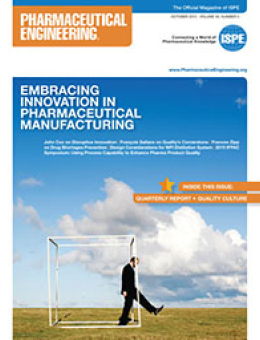
Downloads
Future Factories for Manufacturing Flexibility
Cover Story: In the 1970s, Nucor, which had been a nuclear energy company, decided to pivot vertically into steel manufacturing. It transformed traditional production, lowering costs by using scrap metal and electric arc furnaces instead of the more expensive iron ore and blast furnaces on which companies like Bethlehem Steel relied. Nucor was so successful at capturing the lower end of the steel market, making rebar and other low-quality steel products with its mini-mills, that it disrupted the integrated steel mill industry. It eventually became the largest steel producer in the US.1
Culture is the Cornerstone of Quality
Guest Editorial: Delivering safe and efficacious products to patients and care-givers is the healthcare industry’s greatest responsibility. The critical path to achieving this and fulfilling our responsibility is embedding quality in everything we do, and more importantly, into the thinking and actions of everyone in the system.
Online Exclusive: Quarterly Report - Quality Culture
Four articles addressing how quality plays a role in design.
Six Degrees of Shortage Prevention: ISPE Debuts New Gap Analysis Tool
by Frances (Fran) M. Zipp, President of Lachman Consultant Services, Inc. and Member of ISPE Board of Directors
Performance Characteristics and Alternative Approaches for the ASTM E2709/2810 (CUDAL) Method for Ensuring that a Product Meets USP Uniformity of Dosage Units
This article presents the methodology of ASTM 2810 and demonstrates the method’s conservative nature. Additionally, alternative methodologies to ASTM 2810 are illustrated and their performance is compared to the USP criteria.
Profile: Two Ground-Breaking Products Could Be the Wave of the Future for Bürkert Fluid Control Systems
Air Filtration Challenges and Answers for Dry Heat Sterilization Tunnels
Dry-heat sterilization/depyrogenation may well be one of the most critical steps in the sterile manufacturing process. This paper analyzes the main challenges of high-temperature HEPA filter design and describes a new development that addresses these challenges, promising a more reliable operation and longer life.
Design Considerations for WFI Distillation Systems for Improving Quality, Project Performance and Equipment Life Cycle Cost Reduction
This article presents and discusses a number of key requirements and design, quality, and engineering considerations that have high importance in end-user usability, cost control and end-product quality that help manage risks in Water for Injection production and processes.
Automated Washing Principles and Common Mistakes
This article will explain how some key process parameters, such as time, temperature, chemistry, coverage, and mechanical action, can affect the performance of an automated washing system. It will also discuss best practices for selecting appropriate chemistries and loading accessories and how to avoid common mistakes when using automated washing systems.
Online Water Bioburden Analyzers: A Case Study for the Extension of Purified Water Hold Times
This article presents the use of online water bioburden analyzers, a biological auto-fluorescence enhanced particle counter, to continuously monitor a pharmaceutical purifi ed water system. We describe the applications and business benefi ts of this new class of water analyzers.
Symposium Summary Report: Using Process Capability to Enhance Pharmaceutical Product Quality
This report summarizes speaker and audience interplay and the main points of the 2015 IFPAC symposium “Using Process Capability to Enhance Pharmaceutical Product Quality.”